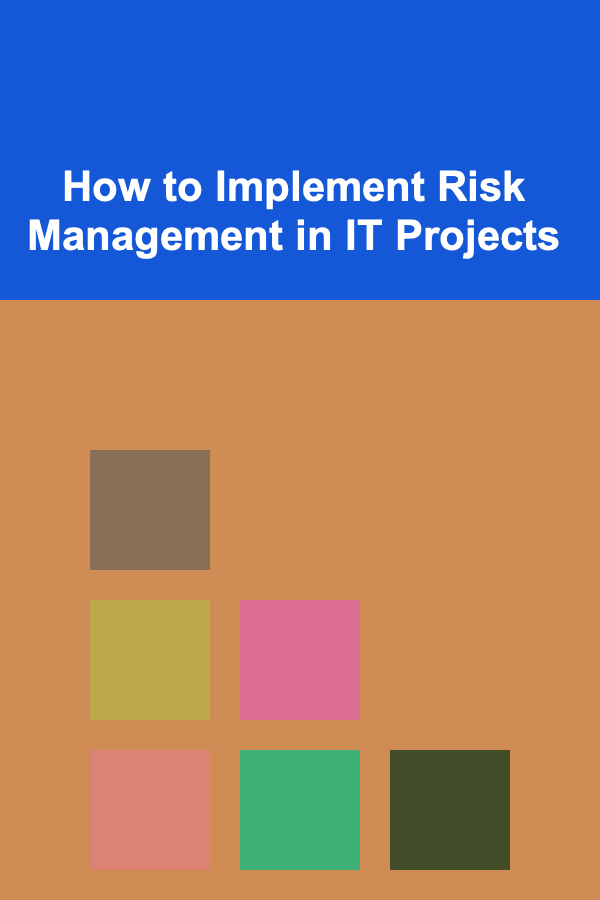
How to Implement Risk Management in IT Projects
ebook include PDF & Audio bundle (Micro Guide)
$12.99$9.99
Limited Time Offer! Order within the next:

Risk management is a critical component of any project, particularly in Information Technology (IT) projects, which are often complex, dynamic, and resource-intensive. Managing risk in IT projects effectively can mean the difference between success and failure, especially in an environment where technological innovations, market needs, and project goals evolve rapidly.
This comprehensive guide will delve into the importance of risk management in IT projects and provide a systematic approach to identifying, assessing, mitigating, and monitoring risks. By the end of this article, you'll be equipped with the knowledge and tools needed to implement effective risk management in your IT projects.
Understanding Risk in IT Projects
In IT projects, risks can be anything that could potentially prevent the project from meeting its objectives, timeline, or budget. These risks can arise from various sources, including technological challenges, resource limitations, external dependencies, regulatory issues, or even human errors.
Some common risks in IT projects include:
- Technical Risk: Related to the technology being used, including hardware failures, software bugs, or compatibility issues.
- Schedule Risk: Concerns about project delays, missed deadlines, or unrealistic project timelines.
- Financial Risk: Involves issues related to cost overruns, lack of budget, or unexpected financial constraints.
- Stakeholder Risk: Arises from misalignment between project stakeholders, including sponsors, team members, or external partners.
- Operational Risk: Refers to disruptions in day-to-day operations that may affect the project, such as system downtimes or resource shortages.
- Compliance and Legal Risks: Associated with meeting regulatory requirements, data privacy laws, or intellectual property concerns.
Actionable Tip:
To start, clearly define what risk means within the context of your project. Understanding the specific environment and challenges you're dealing with will help you address risks more effectively.
The Importance of Risk Management in IT Projects
Risk management is essential for several reasons:
- Anticipating Problems: It helps project managers and teams foresee potential problems and prepare for them before they occur.
- Optimizing Resources: By identifying risks early, you can allocate resources more efficiently to mitigate the impact of these risks.
- Improving Decision-Making: A proactive approach to risk allows for better decision-making, as stakeholders can weigh the pros and cons of various solutions.
- Minimizing Costs: Addressing risks early in the project lifecycle can save significant costs compared to addressing them later.
- Ensuring Project Success: Effective risk management leads to better control over the project, increasing the likelihood of delivering the project on time, within scope, and under budget.
Steps in the Risk Management Process
Implementing risk management in IT projects follows a structured process. This process allows you to systematically identify, assess, mitigate, and monitor risks throughout the project lifecycle.
Step 1: Risk Identification
The first step in risk management is identifying the risks that could impact the project. Effective risk identification requires collaboration from various stakeholders, including project managers, team members, and external partners. Some strategies to identify risks include:
- Brainstorming Sessions: Gather key team members and stakeholders to discuss potential risks.
- SWOT Analysis: Assess the Strengths, Weaknesses, Opportunities, and Threats related to the project. This can uncover internal and external risks.
- Historical Data: Review past projects and document the risks that were encountered and how they were managed.
- Expert Judgment: Consult with industry experts or team members with relevant experience to identify potential risks.
Tools for Risk Identification:
- Risk Register: A central document where all identified risks are logged, categorized, and tracked.
- Risk Breakdown Structure (RBS): A hierarchical framework that categorizes risks based on their source (e.g., technical, external, organizational).
Step 2: Risk Assessment
Once risks are identified, the next step is assessing their potential impact on the project. This involves two key elements:
- Risk Likelihood: The probability that a risk will occur. This can be rated on a scale (e.g., low, medium, high).
- Risk Impact: The severity of the consequences if the risk occurs. Again, this is usually rated on a scale (e.g., minor, moderate, severe).
By multiplying the likelihood and impact ratings, you can prioritize risks, identifying which ones need immediate attention and which ones can be monitored.
Risk Assessment Techniques:
- Qualitative Risk Assessment: Uses subjective measures to rank risks based on likelihood and impact.
- Quantitative Risk Assessment: Uses numerical values and statistical models to calculate the potential effect of risks on the project.
Step 3: Risk Mitigation and Response Planning
Once risks have been assessed, it's time to develop strategies to mitigate or manage these risks. There are several risk response strategies, depending on the nature of the risk:
- Avoidance: Alter the project plan to eliminate the risk or prevent it from occurring.
- Mitigation: Take steps to reduce the likelihood or impact of the risk. This might include implementing additional controls or procedures.
- Transfer: Shift the risk to another party (e.g., through insurance or outsourcing).
- Acceptance: Acknowledge the risk and prepare to deal with it if it occurs, without taking proactive measures to prevent it.
Creating a Risk Response Plan:
A Risk Response Plan should include the following:
- The specific actions to be taken to mitigate or manage each risk.
- Assigning responsibility for each action (who will take charge).
- The timeline for implementing these actions.
Step 4: Risk Monitoring and Control
Risk management is an ongoing process that requires continuous monitoring and updating. As the project progresses, new risks may emerge, and existing risks may change in severity or likelihood. To stay on top of these developments:
- Track Identified Risks: Use tools like a Risk Register to track the status of risks, mitigation efforts, and any new developments.
- Monitor Triggers: Identify specific risk triggers, such as key milestones, that will signal whether a risk is becoming more likely to occur.
- Regular Risk Reviews: Hold regular meetings with project stakeholders to discuss the status of risks and any changes that need to be made to the risk management strategy.
Actionable Tip:
Set up regular project reviews (weekly, bi-weekly, or monthly) to assess the risk management process and make adjustments as needed.
Key Tools and Techniques for IT Project Risk Management
There are several tools and techniques that can help you manage risk in IT projects effectively. Below are some of the most common ones:
Risk Register
A Risk Register is a document that lists all identified risks, their likelihood, impact, and mitigation strategies. This tool allows project managers to track risks throughout the project lifecycle and ensure that responses are effectively implemented.
Gantt Charts and Project Dashboards
Gantt charts and project dashboards provide a visual representation of project timelines, milestones, and progress. They can also be used to track risks by marking potential risk areas and monitoring their resolution.
Risk Assessment Matrix
A Risk Assessment Matrix is a visual tool used to assess and prioritize risks. It typically uses a grid to plot the likelihood against the impact, helping project managers focus on high-priority risks.
Monte Carlo Simulation
For quantitative risk analysis, Monte Carlo simulations use statistical models to predict the likelihood of different outcomes based on known risk factors. This is particularly useful for complex IT projects with multiple variables.
Best Practices for Effective Risk Management in IT Projects
While the process outlined above provides a systematic approach to managing risks, there are several best practices that can improve your overall risk management efforts:
1. Establish a Risk-Aware Culture
Foster a risk-aware culture within your project team by encouraging open communication about risks. The more your team members feel comfortable discussing potential issues, the better equipped you will be to handle them.
2. Engage Stakeholders Early
Involve all key stakeholders in the risk management process from the outset. Stakeholder input is invaluable in identifying and addressing potential risks.
3. Use Agile Methodologies
Agile methodologies, such as Scrum or Kanban, focus on iterative progress and flexible responses to change. These approaches allow you to manage risks more effectively by adapting the project as new risks emerge.
4. Document Everything
Keep comprehensive records of all risks, assessments, mitigation strategies, and responses. This documentation is critical for future reference and can help you improve risk management in future projects.
5. Train Your Team
Ensure that your team is well-trained in risk management techniques and tools. Providing regular risk management training can help everyone involved in the project spot risks early and respond accordingly.
Conclusion
Risk management is an essential discipline in IT projects. It involves identifying potential threats to the project's success, assessing their impact, and proactively addressing them to minimize disruptions. By following a systematic approach---starting with risk identification, followed by assessment, mitigation, and monitoring---you can effectively manage risks and increase the likelihood of project success.
Remember, risk management is not a one-time task but a continuous process. As you implement risk management in your IT projects, always be flexible and ready to adjust your approach to account for new risks that arise. By doing so, you'll be better prepared to deliver successful IT projects that meet the needs of your stakeholders.
Reading More From Our Other Websites
- [Personal Investment 101] How to Effectively Rebalance an Investment Portfolio with a Mix of Index Funds and Savings
- [Simple Life Tip 101] Best Budget‑Friendly Upcycling Projects for Holiday Gifts
- [Organization Tip 101] How to Create a Visual Guide for Your Essential Oil Collection
- [Home Soundproofing 101] How to Use Curtains and Drapes to Block Noise Effectively
- [Home Staging 101] How to Use Artwork and Decor to Stage Your Home
- [Digital Decluttering Tip 101] Smart Tagging & Metadata: How to Use Keywords, Dates, and Locations to Sort Your Pics
- [Home Storage Solution 101] How to Create a Smart Storage System for Your Entryway
- [Organization Tip 101] How to Organize Your Recipe Files for Maximum Efficiency
- [Polymer Clay Modeling Tip 101] From Soft to Stunning: Beginner's Guide to Mastering Clay Modeling
- [Digital Decluttering Tip 101] The Ultimate Guide to Cloud-Based Photo Management

How to Maintain Your Home's Appliances for Longevity
Read More
How to Save Space in a Studio Apartment with Clever Layouts
Read More
How to Set Up a Checklist for Organizing Your Seasonal Items
Read More
How To Identify Marine Fish Species
Read More
How to Move Across Country: An Ultimate Checklist
Read More
How to Draw Cartoon Animals: A Beginner's Guide
Read MoreOther Products

How to Maintain Your Home's Appliances for Longevity
Read More
How to Save Space in a Studio Apartment with Clever Layouts
Read More
How to Set Up a Checklist for Organizing Your Seasonal Items
Read More
How To Identify Marine Fish Species
Read More
How to Move Across Country: An Ultimate Checklist
Read More